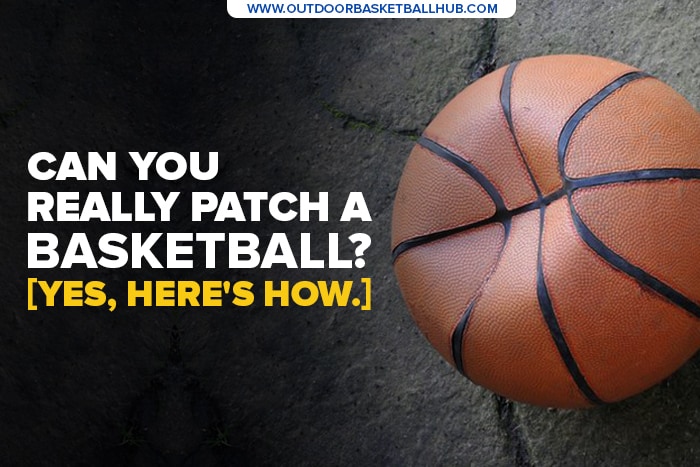- The Jump Manual Review By A Pro Player [Bonus Included] - September 23, 2023
- 3 Best Basketball Shoes For Casual Wear [September 2023] - September 3, 2023
- 5 Best Basketball Shoes For Jumping [September 2023] - August 25, 2023
We’ve all been there; the dreaded ‘psssss’ sound of a leaking basketball as you play or the lumpy, distorted mess a ball inevitably becomes. Nobody wants to be there, but it’s par for the course and comes with the territory of being a basketball player or any athlete playing ball sports.
The average basketball lasts about five years, back and forth and up and down the court. To extend their lifespan and for balls with a sentimental value, many hoopers rely on patching and/or repairs to ensure they get the most out of their game.
That’s why a valid question is: “can a basketball be patched?”
Your ball may be leaking, but you don’t always need to replace it. A basketball can be patched, and here we take a look at the best ways to go about it.
Let’s take a closer look at how to fix your leaking basketball.
Contents
Can A Basketball Be Patched?
Yes, you can absolutely patch a basketball. Both leather and rubber balls will lose air or leak at some point in their life after diligent dribbling and hard play.
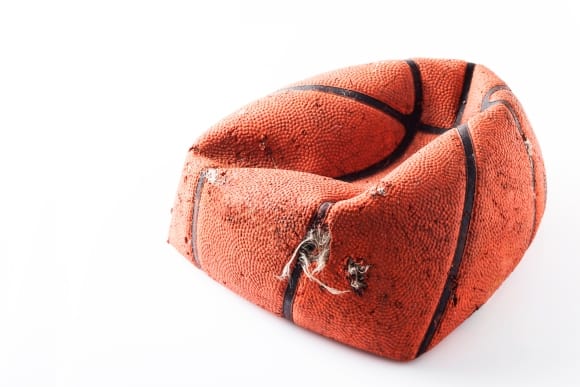
The NBA ensures the integrity of their balls by swapping them out every 1-4 games. For the average hooper using a rubber ball posting up at the neighborhood court, swapping out balls after every pickup game just isn’t doable; that’s where patching comes in.
Proper ball care can only take you so far, and to get the most out of your game and for longer, here are the best patching and fixing methods.
What Is The Best Way To Patch a Basketball
The best way to patch a basketball will depend on the nature of your air leak. The first step is going to be locating the leak.
How To Identify An Air Leak On A Basketball?
Inflate the ball using an air pump and submerge it in a bucket of water. From there, locate any air bubbles escaping from your ball.
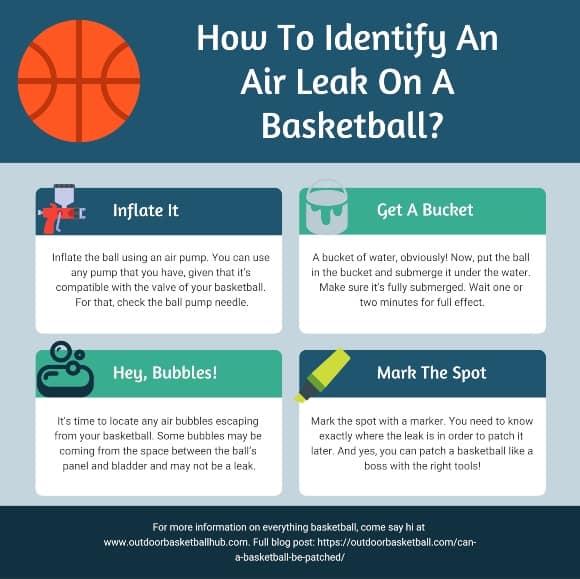
It’s important to note that some bubbles may be coming from the space between the ball’s panel and bladder and may not be a leak.
These bubbles should stop once the trapped air is released; continuous bubbles mean you got yourself a leaking basketball. In this case, or any other holes and leaks, mark the spot with a permanent marker.
From here, the best way to patch a basketball will be based on the most common results of why a basketball deflates and loses air: valve leaks, small holes, or seam leaks.
What Are The Main Reasons For A Basketball To Lose Air?
Valve Leaks
The most common leak you’ll find in basketballs is the valve leak. It’s the result of heavy usage, as the valve hole itself is relied on to keep your ball inflated in the first place.
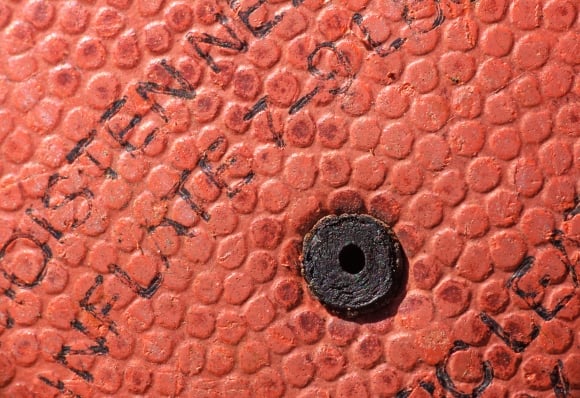
Basketballs (both indoor and outdoor balls) are constructed with an outer vinyl or leather coating, with an internal rubber air bladder, while rubber balls are missing this bladder system.
The bladder contains the valve, which can be opened and filled by a hollow needle into the valve to inflate the ball. As the needle is withdrawn, the valve is sealed.
If you have a valve leak, that means the air inflated into your ball is no longer containing itself in the ball’s bladder.
If you can locate bubbles emanating from the center of the ball while it’s submerged, you have a leaky valve. First, clean the valve with a wet inflating needle to wash away any dirt or debris you may have in the ball’s bladder.
With these kinds of leaks, proper replacement with a new valve is the best way to go. You could always plug the valve with some form of leather stripping that’s melted down, but it’s more of a temporary solution to a bigger problem.
Watch this useful video on the topic!
Soak your new valve in soapy water, then open the valve hole and screw it tightly into place. To ensure you’ve replaced the valve correctly, inflate the ball and let it sit for 24 hours, checking the next day for ball pressure and elasticity.
If replacing your valve isn’t doable, many hoopers comment on the tried-and-true method of plugging your valve with a toothpick by inserting the pick and breaking it off inside the ball, remaining flush with the ball’s surface. Again, this is a short-term fix, and your leak will most likely return.
Small Holes
Small holes are related to hooping on outdoor courts, uneven or wet playing surfaces, or as a result of over-inflating. These kinds of leaks are not uncommon for most basketballs.
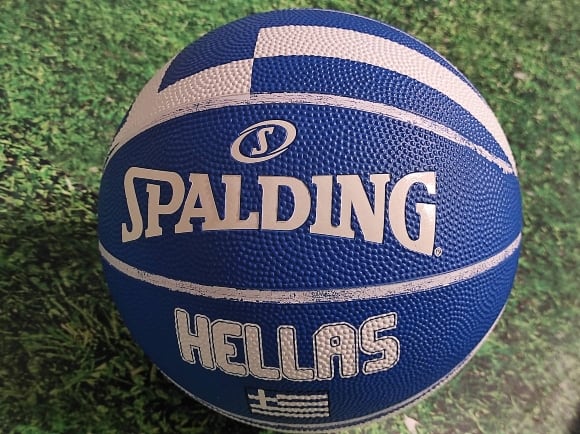
There is a hole or a surface leak if bubbles are coming from the surface of the ball when your ball is submerged in water. To fix this, you can use a ball repair sealant kit, where an insertion needle found on the can is moistened, pushed into the valve, and sprayed.
After that, briefly bounce your basketball (no more than five times) to allow the sealant to be evenly distributed on the inside of the ball’s bladder. Then, your ball should sit for an hour with the hole facing the ground, letting the sealant settle.
These user-friendly patching kits seal up small holes fast, but are only suited for leather balls. For other alternatives, if you have a vinyl basketball, you can heat a hot knife or screwdriver over an open flame and place it over the hole, almost like you’re searing the leak.
I recommend using a dull knife for obvious safety reasons.
Seam Leaks
Seam leaks are natural leakage for all bladder system balls, as the materials and the dots expand over time. The seams of the iconic, modern basketball are hidden behind crisscrossed black lines.
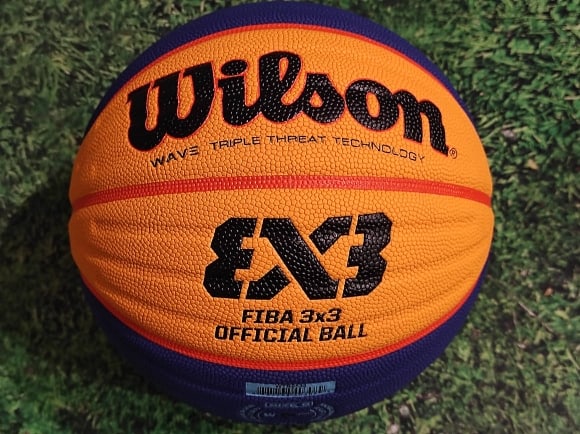
As the seams open, the sensitive internal bladder of the ball is damaged by the seams on the surface or by sand, dirt, debris, etc., being lodged into it.
Seam repairs require an experienced hand with a needle and thread, as well as sealant. We can’t emphasize enough that you consult a professional for these kinds of repairs.
Not only will they be able to reseal the seams of your ball with threading and stitching, but they can also test the integrity of your ball’s bladder. The downside here is that the cost of repairing your leather ball may be greater than buying a new one.
If your basketball has sentimental value, I’d still recommend a quick google search for a professional ball repair service. This brings me to my next point.
Is It Better To Patch A Basketball Or Buy A New One?
It’s better to patch or fix a basketball rather than buying a new one, in the case of repairs costing less than buying a replacement. This is generally known as the 50% rule, and while it’s usually applied to the higher ticket, techy items, the same goes for fixing basketballs.
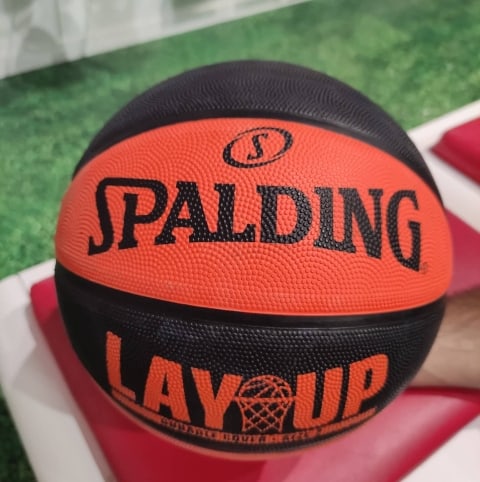
If the cost of repairing your leaking basketball exceeds 50% of the price of a new one, you should be replacing your ball. In the case of seam leaks on regularly relied-on basketballs, you’re better off with a new ball.
A repair or patching kit for valve and little hole leaks will cost you less than $10, while a new basketball goes for over $20. It’s a no-brainer here to stick to repairing the rock rather than swapping it out.
What Are The Best Tools For Repairing A Basketball?
We answered the question, “can a basketball be patched.” Now it’s time to see what are the tools needed for that. For most valve repair kits, the necessary tools included are replacement valves, a crochet hook to open the valve chamber, and air needles to increase air pressure.
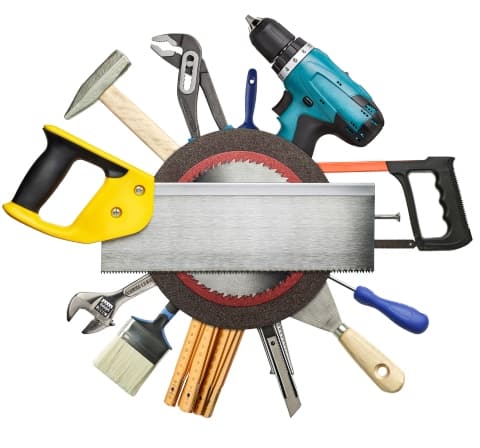
These three tools are required for valve repair and to give your basketball a new life. For small hole and seam repair, sealant is required to pressurize your ball and fully plug any air leaks.
The best tools to fix a basketball will work on balls with a bladder, as bladder composition is the most popular design among modern basketballs. Recent posts and reviews of Amazon ball repair products are a reminder to read the product descriptions.
Negative online reviews of these products are a result of hoopers only realizing the tools they ordered weren’t compatible with their ball’s inner air chamber or surface material after they’d already been delivered.
FAQ
How Do You Fix A Hole In A Basketball?
You can fix a hole in a basketball by locating the hole and using a ball repair sealant kit. You’ll be inserting a needle and spraying the interior bladder of your ball, thereby plugging up the hole so no more air can escape.
Can You Fix A Flat Basketball?
Yes, you can fix a flat basketball by inflating it to its full air pressure with a pump and submerging it in water. You’ll be able to identify air leakage and patch or use a repair kit from there to restore your basketball’s health.
How Do You Fix A Lumpy Basketball?
To fix a lumpy basketball, you’ll need to fully deflate the ball, then pump it up at a lower air pressure level than you would need while playing. Some lumps in basketballs can be a result of over-inflating your ball. If that doesn’t work, run your ball under warm water and use your hands to buff out the deformities.
Can You Replace The Valve In A Basketball?
You can replace the valve in a basketball by finding a compatible valve for your ball, removing the previous valve via a crochet hook, and inserting the new one. This will only work on leather balls, as vinyl basketballs have a bulkier weave than rubber balls.
Why Does My Basketball Keep Deflating?
Your basketball keeps deflating because of either a valve leak, small hole, or seam leak. It’s essential to identify which one by placing your ball in a water bucket and spotting the air bubbles’ source. If the bubbles are coming from the center of your ball, you have a defective valve; if they’re coming from other points of the ball’s surface, it is a seam leak or tiny hole.
How To Plug A Basketball?
You can plug basketballs with a patching kit or drag a blunt, hot knife across the leaky spot for hoopers with steady hands. Patching kits use a liquid insertion method where the liquid hardens and corks the hole in your basketball.

